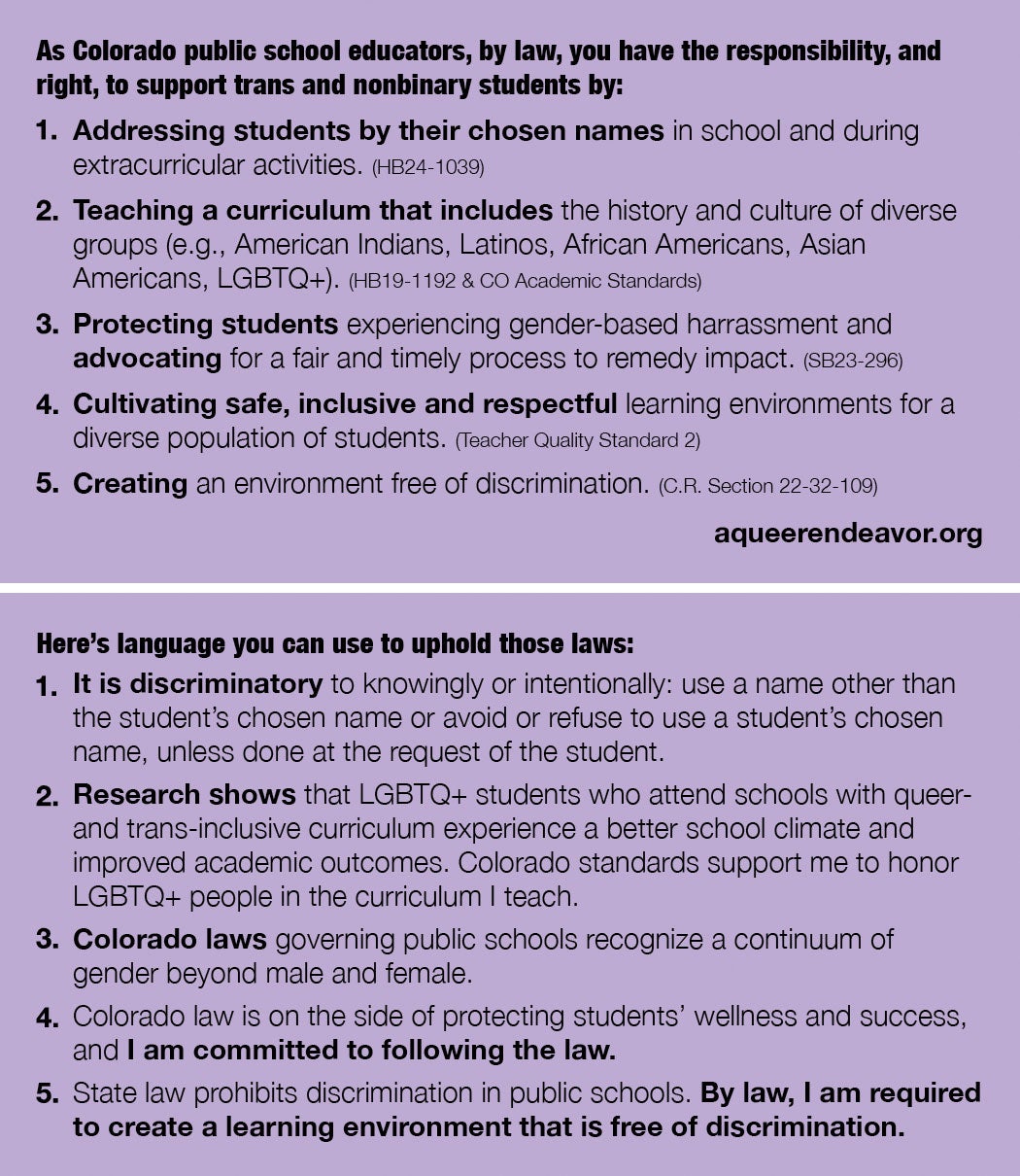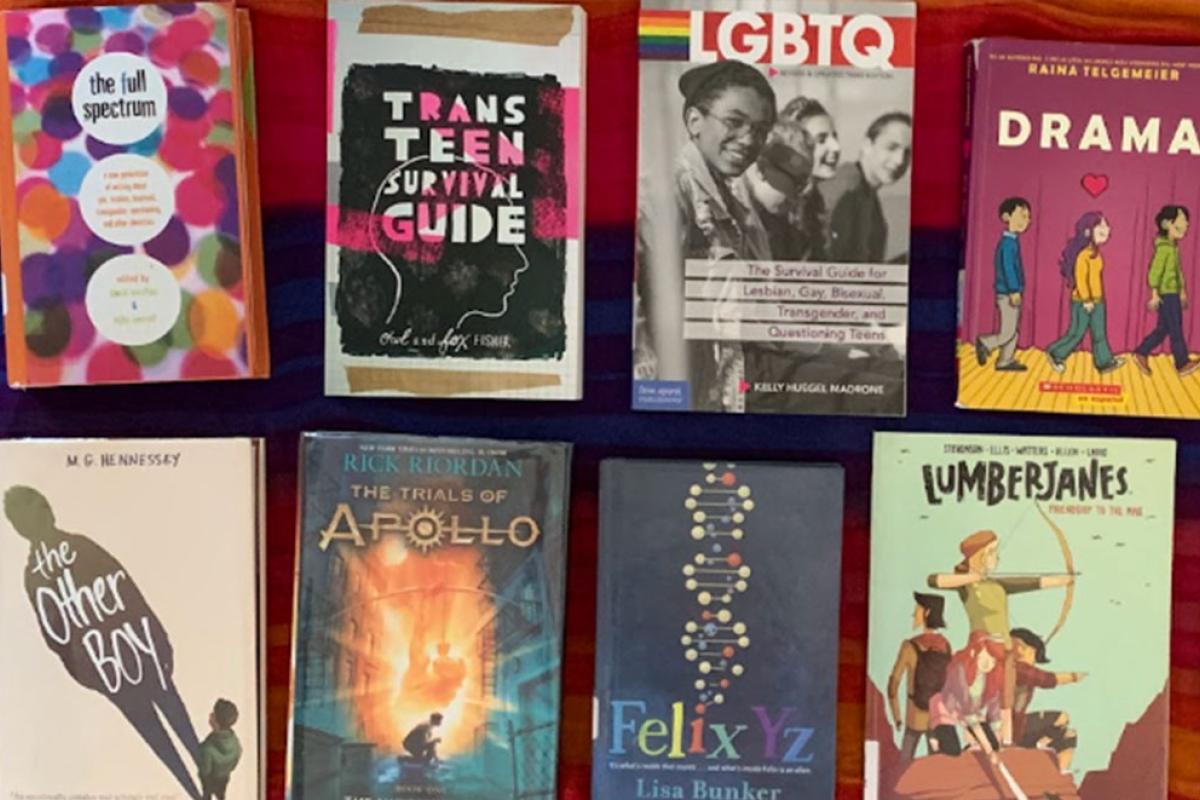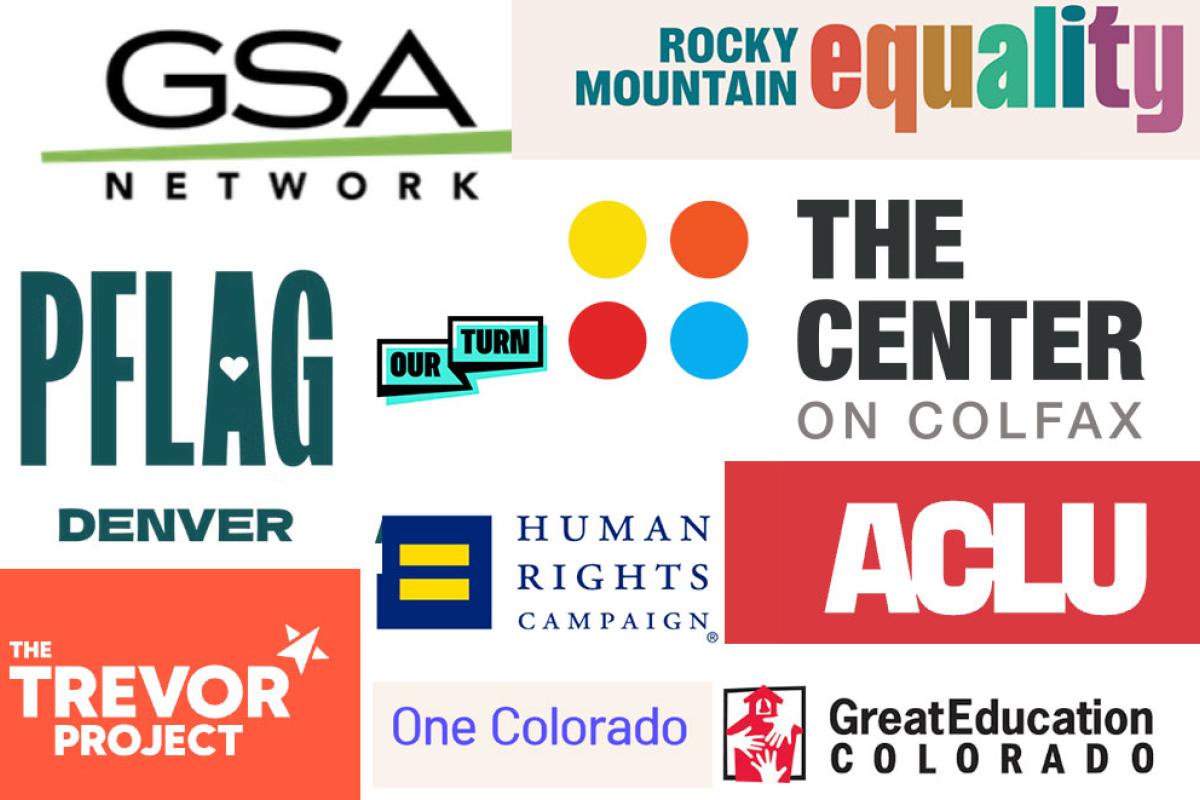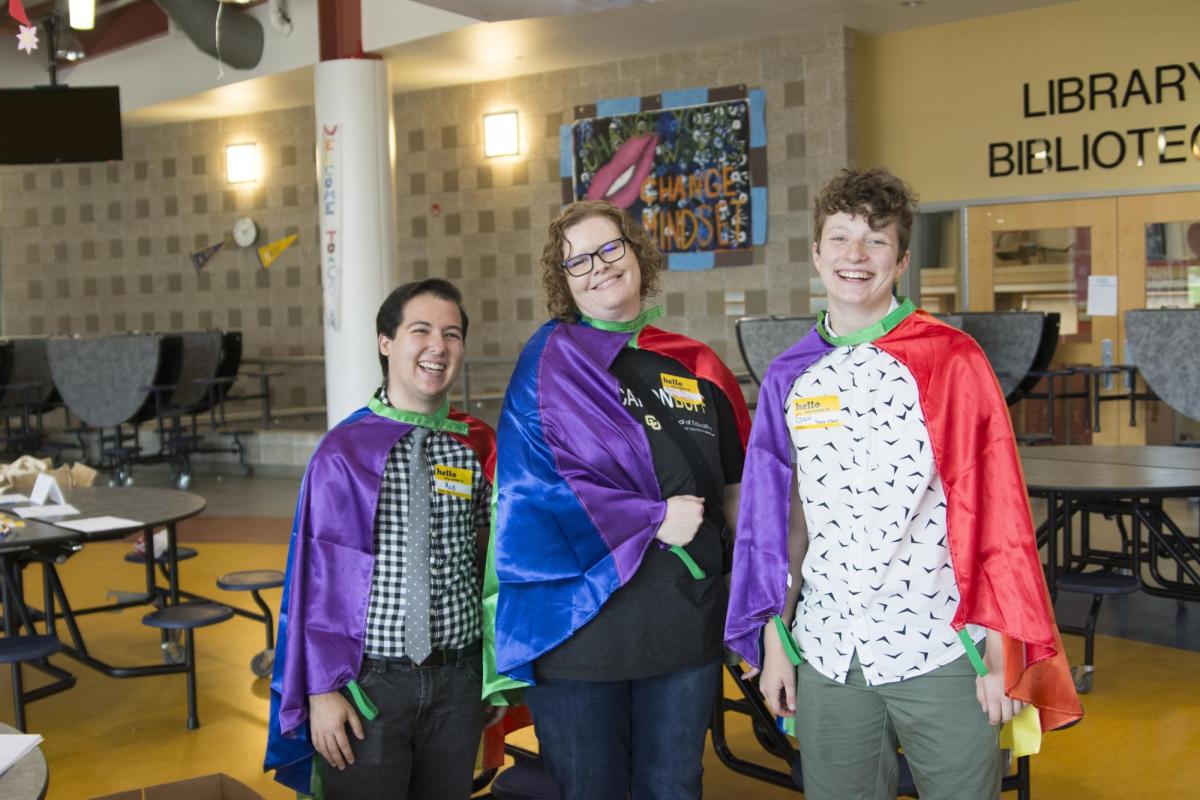For Educators

This page is always changing and being updated! Please contact us if there is anything you would like to see.
Meeting the moment: A resource to support educators.
The purpose of the Lavender Card is to clearly state the laws and policies in Colorado that protect LGBTQ+ students and trans students, specifically, in P-12 public schools. The cards also provide language that educators and youth-serving adults can use to uphold the law. To be sure, the Lavender Card informs people, educators in particular, of their rights and responsibilities.
We hope that you:
- Embrace and embody our shared commitments to democracy, diversity, and justice.
- Not only use/distribute these cards but also continue learning about the stories and lived experiences of communities who are most vulnerable and under threat in the present moment.
- Stand in active solidarity with those communities and alongside people who embody multiple, intersectional identities and are made vulnerable by the current political context.
- Use the Lavender Card in tandem with Red Cards and other resources as part of a larger project of solidarity
- In the midst of so much confusion and fear, ask, How will we actively leverage law and policy to protect and affirm trans and nonbinary youth?
In solidarity and with fire in our socks,
The AQE Team
As Colorado public school educators, by law, you have the responsibility, and right, to support trans and nonbinary students by:
- Addressing students by their chosen names in school and during extracurricular activities. (HB24-1039)
- Teaching a curriculum that includes the history and culture of diverse groups (e.g., American Indians, Latinos, African Americans, Asian Americans, LGBTQ+). (HB19-1192 & CO Academic Standards)
- Protecting students experiencing gender-based harassment and advocating for a fair and timely process to remedy impact. (SB23-296)
- Cultivating safe, inclusive and respectful learning environments for a diverse population of students. (Teacher Quality Standard 2)
- Creating an environment free of discrimination. (C.R. Section 22-32-109)
Here’s language you can use to uphold those laws:
- It is discriminatory to knowingly or intentionally: use a name other than the student’s chosen name or avoid or refuse to use a student’s chosen name, unless done at the request of the student.
- Research shows that LGBTQ+ students who attend schools with queer- and trans-inclusive curriculum experience a better school climate and improved academic outcomes. Colorado standards support me to honor LGBTQ+ people in the curriculum I teach.
- Colorado laws governing public schools recognize a continuum of gender beyond male and female.
- Colorado law is on the side of protecting students’ wellness and success, and I am committed to following the law.
- State law prohibits discrimination in public schools. By law, I am required to create a learning environment that is free of discrimination.
Frames for Talking about Gender, Sexual, and Family Diversity - Inclusive Education
Kids and families aren’t controversial
It’s a matter of respect
We are reflecting and affirming the diversity that already exists in our community
Identity trumps beliefs
Creating safe, inclusive, respectful learning environments: it’s the law
LGBTQ+ Terminology 101 Video
It’s through language that we name and identify ourselves and one another, that we make sense of the world, and that we make each other feel valued and included.
Video created by A Queer Endeavor.
A Queer Endeavor’s Queer-Inclusive Instruction Resource Hub
Below are tools developed by A Queer Endeavor for designing queer-inclusive, standards-based instruction.

Queer(ed) Teaching Practices Snapshots
A Queer Endeavor has synthesized the work of queer pedagogy scholars and their own lived experiences as educators to craft a framework of four queer(ed) teaching practices. Incorporating these practices can better enable educators in supporting all their students to interrogate normativity, power, and oppression.
The snapshots below provide an overview of each teaching practice, along with some tangible starting places for enacting these practices in different contexts. If you’d like more targeted or intensive support in these practices, consider requesting professional development with us.
Introduction: What is Queering?
Practice 1: Include
Practice 2: Questioning What’s Normal
Practice 3: Implicating the Self
Practice 4: Create Conditions to Feel Discomfort & Joy
Other resources for supporting queer-inclusive instruction
The law is on the side of public school educators when it comes to supporting ALL students and creating schools that are a safe place for everyone to learn and to grow. Click here for more information on these laws on policies.
- Boulder Valley School District (BVSD): Gender Support Plan
- Boulder Valley School District (BVSD): Gender Transition Plan
- Boulder Valley School District (BVSD): Gender Name Change Form
If you are looking for LGBTQ+-inclusive texts to include in your classroom, these are great places to start. Remember to look carefully into a text and take stock of your particular context before deciding if a particular text is appropriate for your students.
- LGBTQ+ Inclusive Book Recommendations from Dr. Kaplan, BVSD Librarian
- Lee Wind’s “I’m Here, I’m Queer, Now What the Hell do I Read?”
- The Rainbow Book List for children & teens (created by Rainbow Book List Committee of the American Library Association)
- Goodread’s Best GLBT books for teens
- “Queer Books for Teens” (provides as comprehensive a list as possible of LGBTQ YA published between 2000-2020)
- Penguin’s “Ultimate LGBT Pride Book List”
With this political moment in mind and in the spirit of collective liberation, this list is meant to highlight other organizations doing amazing work with youth, educators, and justice in education more generally.
Please help us grow this list as a resource by filling out this form.
- PFLAG - Denver, Boulder, Find Another Local Chapter
- OASOS (Open and Affirming Sexual Orientation and gender identity Support)
- Inside Out Youth Services (CO Springs & El Paso County)
- SoCo Quiltbag (Fremont County)
- Guide to Being an Ally to Transgender and Nonbinary Youth - The Trevor Project
- Best Practices for Serving LGBTQ Students - Learning for Justice
- In Other Words: This short documentary explores homophobic language and its consequences among teenagers
- De Colores: “A 28-minute bilingual documentary about how Latino families are replacing the deep roots of homophobia with the even deeper roots of love and tolerance.”
- Voices on gender queerism YouTube video.
- Andrea Gibson: Poet & activist. Their website is a gem, especially their poems “Letter to a Playground Bully from Andrea, age 8 ½” and “The Jewelry Store“
- “Growing Up Queer: A Brief Lesson On Hetero- And Homonormativity” blog post written by a young Black, gay man pushing back on what society thinks a “Black” male should be.
- “How You Can Be A Better Ally To Transgender Teens Like Me”: Huffington Post blog on how to be a better ally to trans* teens.
- “Profound Portraits Of Young Agender Individuals Challenge The Male/Female Identity” Huffington Post article on Chloe Aftel’s portrait project “Agender”–a photo series showcasing embodiments of genderqueer identities.
- “Ash Beckham at Ignite Boulder 20”: Ash Beckham’s talk at Ignite Boulder on eliminating the word ‘gay’ as a pejorative from our lexicon. (a great video to use with students to start a discussion about the use of “that’s so gay.”)
- “Hey Dad — I'm Here, I'm Queer, Deal With It” Kai Wright’s coming out story, featured as part of NPR’s “Tell Me More” project.
- “When the Gender Boxes Don’t Fit,” Ericka Sokolower-Shain shares her experience struggling to fit into the gender binary, and Jody Sokolower shares her struggle to confront her own biases and assumptions and support her daughter, who struggles to define her own gender identity.







